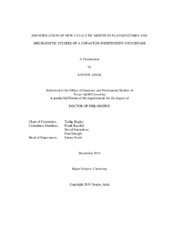| dc.description.abstract | In this dissertation we discuss function identification and detailed mechanistic studies of the enzymes involved in the bacterial xenobiotic, amino acid, and vitamin catabolic pathways. The studies are mainly focused on 1) Identification of flavin-N5-oxide intermediates in bacterial dibenzothiophene, uracil and hexachlorobenzene catabolic pathway; 2) Identification of bacterial folate and lumichrome catabolic pathways; 3) Mechanistic studies on the flavoenzyme (IifA) involved in the bacterial tetramethyl pyrazine catabolic pathway; 4) Mechanistic studies on the cofactor independent oxygenase in the bacterial indole catabolic pathway. Our mechanistic studies on the DszA catalyzed reaction in the bacterial dibenzothiophene catabolic pathway revealed that the reaction proceeds via the flavin-N5- oxide intermediate, a newly discovered flavin oxidation state. DszA is the second enzyme which has been characterized as flavin-N5-oxide utilizing enzyme. Guided by the similar mechanistic hypothesis that we had on the DszA catalyzed reaction, we were able to discover flavin-N5-oxide in the RutA-catalyzed oxidative amide bond cleavage reaction in the uracil catabolic pathway reaction and in the HcbA1-catalyzed dehalogenation reaction in the hexachlorobenzene catabolic pathway.
Unlike the vitamin biosynthesis, the vitamin catabolism is an unwritten chapter in fundamental biochemistry. In an effort to broaden our knowledge on vitamin catabolism we have identified bacterial folate and lumichrome catabolic pathways. Detailed biochemical studies on the folate catabolic pathway in Mesorhizobium loti revealed a unique flavoenzyme mediated Baeyer-Villiger type rearrangement. We have identified a similar Baeyer-villiger type rearrangement in the bacterial tetramethyl pyrazine catabolic pathway. We have also identified a lumichrome catabolic pathway in Pimelobacter simplex and the initial three enzyme catalyzed reactions have been reconstituted in vitro. We have studied the mechanism of a cofactor-independent oxygenase (IifA) involved in the bacterial indole catabolic pathway. IifA catalyzes the transformation of 3-hydroxyoxindole to anthranilic acid. Our mechanistic studies on the IifA catalyzed reaction support a Baeyer-Villiger type rearrangement, first of its kind, in a cofactor-independent enzyme. We have shown that the reaction goes via the isatoic anhydride intermediate, identified bicarbonate as the reaction product, labeling experiments with O-18 labeled water and molecular oxygen showed that the oxygen atom from water molecule incorporated into anthranilic acid product while oxygen atom from molecular oxygen incorporated into carbon dioxide. | en |


